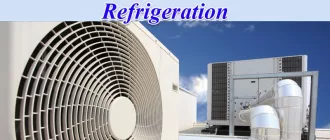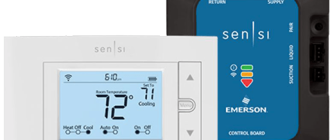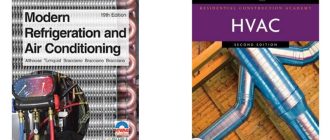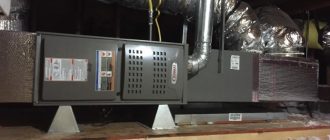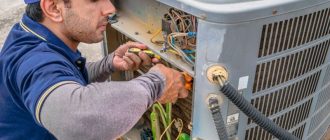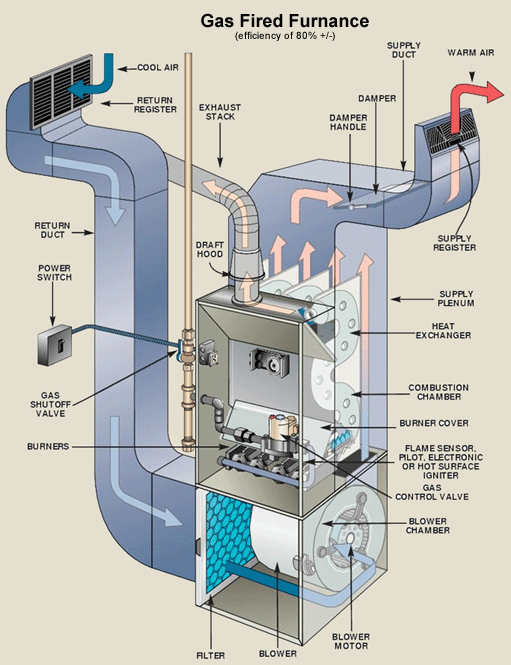
How a Gas Forced-Air Furnace Works
When it comes to heating a home, a gas forced-air furnace is a popular choice for many homeowners. The inner workings of a gas forced-air furnace are fascinating and understanding how it works can give homeowners a better appreciation for this essential home appliance.
A gas forced-air furnace works by circulating warm air throughout the home using a system of ducts. The furnace contains a gas burner that heats up the air and a blower that pushes the heated air through the ductwork and into the different rooms of the house. This type of furnace is called “forced-air” because it uses a fan or blower to force the warm air out into the living spaces.
One important component of a gas forced-air furnace is the heat exchanger. This is where the air is heated as it passes over the burner. The heat exchanger is a metal chamber that allows the combustion gases to pass through while keeping them separate from the heated air. This ensures that the air being circulated in the home is clean and safe to breathe.
Another key component of a gas forced-air furnace is the thermostat. The thermostat is the control panel that allows homeowners to adjust the temperature of their home. When the temperature drops below the desired level, the thermostat sends a signal to the furnace to turn on and start heating the air. Once the desired temperature is reached, the thermostat instructs the furnace to shut off until it is needed again. This helps to maintain a comfortable and consistent temperature throughout the home.
In conclusion, a gas forced-air furnace is a complex system that works together to generate and distribute warm air throughout a home. Understanding how this appliance functions can help homeowners better care for and maintain their furnace, ensuring that it operates efficiently and effectively for years to come.
What is a Gas Forced-Air Furnace?
A gas forced-air furnace is a heating system that uses natural gas as its fuel source to generate heat. It is one of the most common types of furnaces found in residential and commercial buildings. The furnace works by using burners to ignite the natural gas and produce hot combustion gases. These gases are then circulated through a heat exchanger, which transfers the heat to the surrounding air. The heated air is then blown into the building through a network of ducts using a fan, providing warmth throughout the space.
One of the main advantages of a gas forced-air furnace is its efficiency. Gas is a relatively low-cost fuel source, making it an affordable option for heating. The combustion process in a gas furnace is also highly efficient, ensuring that the maximum amount of heat is produced from the fuel. Additionally, the forced-air distribution system allows for even heating throughout the building, making it a comfortable and effective heating solution.
Gas forced-air furnaces are also known for their versatility. They can be used for both heating and cooling purposes by integrating with an air conditioning system. This allows for year-round comfort, as the furnace can provide warm air in the winter and cool air in the summer. The ability to switch between heating and cooling modes makes gas forced-air furnaces an efficient and cost-effective choice for many homeowners and businesses.
| Pros | Cons |
| High efficiency | Requires access to a natural gas supply |
| Even heating throughout the building | Requires ductwork for air distribution |
| Versatility for heating and cooling | May produce dry air and lower humidity levels |
| Relatively low-cost fuel source | Regular maintenance required to ensure optimal performance |
In summary, a gas forced-air furnace is a popular and efficient heating system that uses natural gas as its fuel source. It heats the air through combustion and distributes the warm air throughout the building via ductwork. While it requires access to a natural gas supply and regular maintenance, it offers even heating, versatility, and relatively low fuel costs. Considered the pros and cons, gas forced-air furnaces are a reliable and effective option for heating residential and commercial spaces.
How Does a Gas Forced-Air Furnace Work?
A gas forced-air furnace is a heating system that relies on the combustion of natural or propane gas to generate heat. The furnace uses a series of components to distribute the heated air throughout a home or building, providing warmth and comfort during colder months.
The main components of a gas forced-air furnace include:
Burner: The burner is responsible for igniting the gas and creating a flame. It is typically located within the combustion chamber of the furnace.
Heat exchanger: The heat exchanger is a crucial part of the furnace as it transfers heat from the combustion gases to the air. The hot combustion gases flow through the heat exchanger, while the air from the return ducts passes over the outside of the heat exchanger, picking up the heat.
Blower: The blower is a motor-driven fan that helps circulate the heated air throughout the ductwork and into the different rooms of the building. It is usually located after the heat exchanger and before the supply ducts.
Air filter: The air filter is responsible for removing dust, debris, and other particles from the air before it enters the heat exchanger. This helps improve the air quality and prevents damage to the furnace components.
Thermostat: The thermostat acts as the control center for the furnace. It senses the temperature in the building and signals the furnace to turn on or off based on the desired temperature settings.
When the thermostat detects that the temperature has dropped below the set point, it sends a signal to the furnace to start operating. The burner ignites the gas, creating a flame inside the combustion chamber. The heat exchanger then absorbs the heat from the combustion gases, which heats the air passing over it.
Once the air is heated, the blower fan kicks in and pushes the warm air through the ductwork and into the rooms. This process continues until the thermostat senses that the desired temperature has been reached, at which point the furnace shuts off.
Regular maintenance and inspection of a gas forced-air furnace are essential to ensure its proper functioning and efficiency. This includes cleaning or replacing the air filter, checking the burner and heat exchanger for any damage or blockages, and ensuring that the blower fan is operating smoothly. A well-maintained furnace can provide reliable and efficient heating for many years.
The Main Components of a Gas Forced-Air Furnace
In order to understand how a gas forced-air furnace works, it is important to familiarize oneself with its main components. These components work together to ensure that the furnace efficiently generates and distributes heat throughout a building.
1. Burner: The burner is responsible for igniting the gas fuel, creating a flame that heats up the air inside the furnace.
2. Heat Exchanger: The heat exchanger is a crucial component that transfers the heat generated by the burner to the air. It is designed to maximize heat transfer while preventing the combustion gases from mixing with the heated air.
3. Blower: The blower is responsible for circulating the heated air throughout the building. It draws in air from the return ducts, passes it over the heat exchanger to warm it up, and then pushes it back into the supply ducts for distribution.
4. Thermostat: The thermostat serves as the control center for the furnace. It allows the user to set the desired temperature and automatically triggers the furnace to turn on and off to maintain that temperature.
5. Air Filter: The air filter helps to maintain the air quality by trapping dust, allergens, and other particles before they are distributed throughout the building. It is important to regularly clean or replace the air filter to ensure optimal airflow and efficiency.
6. Venting System: The venting system is responsible for safely removing the combustion gases produced by the burner. It directs the gases outside the building through a flue or chimney, preventing the risk of carbon monoxide buildup.
7. Ductwork: The ductwork consists of a series of pipes or channels that distribute the heated air throughout the building. Properly designed and maintained ductwork ensures that the heated air reaches all areas of the building in an efficient manner.
By understanding the main components of a gas forced-air furnace, one can better appreciate how these components work together to provide warmth and comfort in a building. Regular maintenance and upkeep of these components are crucial to ensure the furnace operates safely and efficiently.
The Burner
The burner is a crucial component of a gas forced-air furnace. It is responsible for igniting and burning the fuel, which in turn generates the heat needed to warm the air in the furnace.
When the thermostat detects that the temperature in the house is lower than the desired setting, it sends a signal to the burner to start working. The burner receives a supply of natural gas or propane, which is mixed with air to create a combustible mixture.
Inside the burner, there is an ignition system that provides a spark or heat to ignite the fuel mixture. Once ignited, the mixture produces a flame that burns continuously as long as the thermostat is calling for heat.
The burner is designed to create a controlled flame that efficiently burns the fuel. It is equipped with safety features such as flame sensors and pressure switches to ensure that the flame is present and that the fuel is burning properly. If any abnormal conditions are detected, these safety features will shut off the fuel supply to prevent accidents.
It is important to keep the burner clean and free from debris to ensure its proper functioning. Regular maintenance and inspection of the burner are necessary to prevent any issues with the furnace and to maintain its efficiency.
In conclusion, the burner plays a critical role in the operation of a gas forced-air furnace. Understanding how it works and ensuring its proper maintenance is key to keeping your furnace running smoothly and efficiently.
The Heat Exchanger
The heat exchanger is a critical component in the functioning of a gas forced-air furnace. It is responsible for transferring heat from the combustion process to the air that is circulated throughout the home. The heat exchanger works by allowing the combustion gases to flow through its tubes or fins, while the blower fan blows air over the surface of the heat exchanger.
As the combustion gases pass through the heat exchanger, they give off heat, which is then transferred to the metal surface of the heat exchanger. The air from the blower fan, which is usually driven by a motor, is drawn in through the air intake and forced over the hot surface of the heat exchanger. This causes the air to become heated, and it is then distributed throughout the home via the forced-air system.
The design of the heat exchanger is crucial in ensuring efficient and safe operation of the furnace. It must be able to withstand the high temperatures generated during combustion and prevent any leakage of combustion gases into the circulating air. A cracked or defective heat exchanger can be a serious safety hazard, as it can lead to the release of carbon monoxide into the home.
Regular maintenance and inspection of the heat exchanger are essential to ensure its proper functioning and to detect any potential issues. It is recommended to have a professional HVAC technician inspect the heat exchanger during annual furnace servicing to ensure its integrity and safety.
In conclusion, the heat exchanger plays a vital role in the operation of a gas forced-air furnace. It transfers heat from the combustion process to the air circulated throughout the home, ensuring comfort and warmth during cold weather. Regular maintenance and inspection are necessary to ensure the efficiency and safety of the heat exchanger.
The Blower Motor
The blower motor is a crucial component in the operation of a gas forced-air furnace. It is responsible for distributing heat generated by the furnace throughout the home. The blower motor uses electricity to spin a fan, which then pushes the heated air through the ductwork and into the different rooms.
The blower motor works in conjunction with the furnace’s burner and heat exchanger. When the thermostat detects a drop in temperature, it sends a signal to the furnace to start the heating process. The burner ignites the gas, creating a flame that heats up the heat exchanger. As the heat exchanger warms up, the blower motor is activated to start circulating the heated air.
The blower motor is typically installed in the furnace’s air handler. It is connected to the heat exchanger and the ductwork. The motor itself consists of a motor housing, a fan, and an electrical connection. The motor housing houses the motor and protects it from debris and dust. The fan is attached to the motor shaft and spins to move the air. The electrical connection allows the motor to receive power and control its speed.
The blower motor can be single-speed or variable-speed. A single-speed motor operates at a constant speed, while a variable-speed motor can adjust its speed based on the demand for heating or cooling. Variable-speed motors are more energy-efficient and provide better comfort control as they can operate at lower speeds during milder weather. However, they are more expensive than single-speed motors.
Regular maintenance and cleaning of the blower motor are important to ensure its proper functioning. Dust and debris can accumulate on the fan blades and motor housing, reducing airflow and efficiency. A dirty blower motor can also lead to increased energy consumption and reduced heating performance. It is recommended to clean the blower motor and its components at least once a year or as per the manufacturer’s instructions.
| • The blower motor distributes heated air throughout the home. |
| • It works in conjunction with the furnace’s burner and heat exchanger. |
| • The motor housing, fan, and electrical connection are key components of the blower motor. |
| • The blower motor can be single-speed or variable-speed. |
| • Regular maintenance and cleaning are necessary for optimal performance. |
The Flue Pipe
The flue pipe is an essential component of a gas forced-air furnace system. It is responsible for safely removing the byproducts of combustion from the furnace and venting them outside.
During operation, the furnace burns the fuel, typically natural gas, to generate heat. As a result, various gases and particles are produced, including carbon monoxide, water vapor, sulfur dioxide, and nitrogen oxides. These byproducts need to be expelled from the furnace to prevent them from entering the living space, as they can be harmful to human health.
The flue pipe connects to the furnace’s exhaust port and extends vertically through the roof or sidewall of the house. It is made of a durable metal material, usually galvanized steel or stainless steel, to withstand the high temperatures and corrosive nature of the combustion byproducts.
Inside the flue pipe, there is a continuous flow of gases moving upward, driven by the natural buoyancy and the negative pressure created by the furnace’s blower. The flue pipe is designed with the appropriate diameter to allow for efficient exhaust airflow, ensuring that the byproducts are expelled quickly and without obstruction.
To enhance the safety of the system, the flue pipe is equipped with several important components. These include a flue cap or rain hood at its termination point to prevent water from entering the system, a draft hood or draft diverter near the furnace to regulate the air intake, and a flue damper for controlling the exhaust airflow.
Regular maintenance and inspections of the flue pipe are essential to ensure its proper functioning. Over time, the flue pipe may develop cracks, corrosion, or blockages, which can compromise its ability to remove the combustion byproducts safely. Any issues with the flue pipe should be addressed promptly by a qualified HVAC technician to avoid potential safety hazards.
In conclusion, the flue pipe plays a crucial role in the operation of a gas forced-air furnace system. It safely vents the byproducts of combustion outside the home and helps maintain a healthy indoor environment. Regular maintenance and inspection of the flue pipe are necessary to ensure its optimal performance.
The Thermostat
The thermostat is an essential component in the operation of a gas forced-air furnace. It is responsible for regulating and maintaining the desired temperature in a home or building. The thermostat works by sensing the current temperature in the space and comparing it to the set temperature.
When the temperature falls below the set point, the thermostat sends a signal to the furnace to start heating. The gas is then ignited, and the heat exchanger warms up. The blower fan then kicks in, forcing the heated air through the ducts and into the living space.
Once the temperature reaches the desired level, the thermostat signals the furnace to stop heating. The gas is shut off, and the blower fan continues running for a short period of time to distribute the remaining warm air. This cycle repeats as necessary to maintain the desired temperature.
Modern thermostats often come with programmable features, allowing homeowners to set different temperatures for different times of the day. This can help to save energy and reduce heating costs. Some thermostats even have smart technology, which can be controlled remotely through a smartphone app or even through voice commands.
Overall, the thermostat plays a crucial role in the operation of a gas forced-air furnace. It ensures that the home or building stays comfortable and heated to the desired temperature. Without the thermostat, the furnace would not know when to start and stop, leading to inefficient and inconsistent heating.
Types of Gas Forced-Air Furnace
Gas forced-air furnaces are a popular choice for heating homes and buildings. They work by using natural gas or propane to generate heat, which is then distributed throughout the space using a forced-air system. There are several different types of gas forced-air furnaces available, each with its own unique features and advantages.
One type of gas forced-air furnace is a single-stage furnace. This type of furnace has only one setting, meaning it operates at full capacity whenever it is running. Single-stage furnaces are typically less expensive to install and maintain, but they may not provide as precise or efficient heating as other types.
Another type of gas forced-air furnace is a two-stage furnace. This type of furnace has two settings, allowing it to operate at a lower capacity when less heat is needed. This can result in energy savings and more consistent temperature control. Two-stage furnaces are often quieter and more efficient than single-stage furnaces.
A modulating gas forced-air furnace is the most advanced type available. This type of furnace operates at varying capacities to provide precise and efficient heating. Modulating furnaces can constantly adjust the amount of heat output based on the heating needs of the space, resulting in optimal comfort and energy savings. These furnaces are typically the most expensive to install and maintain, but they offer the highest level of performance.
Summary
Gas forced-air furnaces come in different types, including single-stage, two-stage, and modulating furnaces. Single-stage furnaces operate at full capacity, while two-stage furnaces offer varying heat settings. Modulating furnaces provide the most precise and efficient heating. Choosing the right type of gas forced-air furnace depends on your heating needs, budget, and desired level of performance.
Single-Stage Furnace
A single-stage furnace is a type of gas forced-air furnace that operates at full capacity whenever it is running. This means that the burner is either on at full blast or completely off. There is no in-between stage, hence the name “single-stage”.
When the thermostat calls for heat, the control board signals the gas valve to open and the burner flame ignites. The furnace then blows the heated air through the ductwork, delivering warmth to the rooms of the house.
Once the desired temperature is reached, the thermostat signals the furnace to shut off. The burner flame extinguishes, and the blower fan stops blowing. The furnace remains off until the thermostat calls for heat again.
A single-stage furnace is simple in design and easy to operate. It is typically less expensive than other types of furnaces and is suitable for most homes. However, since it only operates at full capacity, it may not be the most energy-efficient option.
If you live in an area where the climate is relatively mild and you don’t need a lot of heating power, a single-stage furnace can be a cost-effective choice. However, if you live in an area with harsh winters or have specific heating requirements, you may want to consider a two-stage or modulating furnace for better comfort and efficiency.
Two-Stage Furnace
A two-stage furnace is a type of gas forced-air furnace that operates in two stages, providing more precise control over the heat output and increasing energy efficiency. This type of furnace works by using a two-stage gas valve and a variable-speed blower motor to deliver heat to the home.
The two-stage gas valve allows the furnace to operate at two different levels of heat output: low-fire and high-fire. During mild weather conditions, the furnace will operate in low-fire mode, which uses a lower gas flow rate and produces less heat. This helps to maintain a consistent temperature in the home and prevent overheating. When the temperature drops, the furnace will automatically switch to high-fire mode, which increases the gas flow rate and heat output to meet the higher demand for heat.
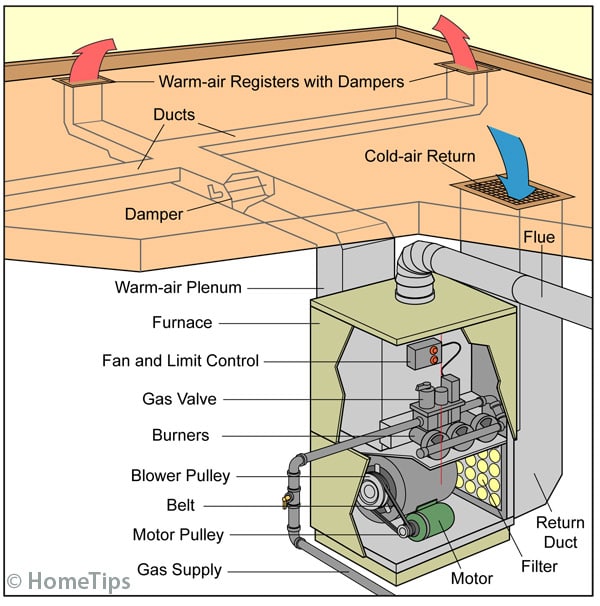
The variable-speed blower motor in a two-stage furnace works in conjunction with the gas valve to optimize energy efficiency. The motor adjusts its speed based on the heating needs of the home, delivering the right amount of airflow to distribute heat evenly throughout the living space. By adjusting the blower speed, the furnace can operate at a lower energy consumption level, saving energy and reducing utility costs.
In addition to energy efficiency, a two-stage furnace also offers other benefits. The two-stage operation provides more consistent and comfortable heating, as it helps to eliminate temperature swings and hot or cold spots in the house. It also helps to reduce noise levels, as the furnace operates at a lower speed for a longer period of time compared to single-stage furnaces. This makes a two-stage furnace a popular choice for homeowners who value comfort and energy efficiency.
| 1. Increased energy efficiency |
| 2. More precise control over heat output |
| 3. Consistent and comfortable heating |
| 4. Reduced noise levels |
Modulating Furnace
A modulating furnace is a type of gas forced-air furnace that works by adjusting the heat output in small increments to match the heating needs of a home. Unlike conventional furnaces that operate at full capacity and then turn off once the desired temperature is reached, a modulating furnace can continuously adjust its heat output to maintain a consistent and comfortable indoor temperature.
This type of furnace uses advanced technology and sensors to monitor the temperature in different areas of the home. It then adjusts the burner flame or blower speed accordingly to provide the precise amount of heat needed. By modulating the heat output, the furnace can achieve better energy efficiency and prevent temperature fluctuations.
A modulating furnace typically has a wide range of heat output options, allowing it to operate at various heating stages depending on the demand. This means that it can provide low heat output during mild weather and increase the output during colder periods. The ability to modulate the heat output also results in quieter operation, as the furnace doesn’t need to constantly turn on and off.
In addition to improving comfort and energy efficiency, a modulating furnace can also help to extend the lifespan of the system. By not constantly cycling on and off, the furnace experiences less wear and tear, leading to fewer repairs and a longer overall lifespan.
| 1. Precise heat output adjustment for optimal comfort |
| 2. Improved energy efficiency |
| 3. Quieter operation |
| 4. Longer lifespan with reduced repairs |
Advantages of a Gas Forced-Air Furnace
A gas forced-air furnace offers several advantages over other heating systems. Here are some of the key benefits:
|
Efficiency: Gas furnaces are highly efficient and can convert a large portion of the fuel they consume into heat. This means that they can effectively and quickly heat your home, resulting in a comfortable living environment. |
|
Cost-effective: Gas is generally more affordable than other fuels such as oil or electricity. This makes gas forced-air furnaces a cost-effective option for heating your home. Additionally, the efficient operation of gas furnaces can also help lower your heating bills. |
|
Reliability: Gas forced-air furnaces are known for their reliability. They typically have fewer maintenance issues compared to other heating systems, which can save you time and money on repairs. |
|
Even heating: A gas forced-air furnace works by distributing heated air throughout your home via ducts. This ensures that every room receives an even and consistent temperature, eliminating cold spots and providing a more comfortable living environment. |
|
Quick heat production: Gas furnaces can produce heat quickly, allowing you to warm up your home efficiently. This is especially beneficial during colder months when you need to heat your home as quickly as possible. |
In conclusion, a gas forced-air furnace offers efficiency, cost-effectiveness, reliability, even heating, and quick heat production, making it a popular choice for many homeowners.
Efficiency
The efficiency of a gas furnace is a measure of how effectively it converts fuel into usable heat. This is important because it directly affects the amount of energy, and therefore money, required to heat a home. A high-efficiency gas furnace can have an annual fuel utilization efficiency (AFUE) rating of 90% or higher, meaning it converts 90% or more of the energy in the gas into heat for your home.
There are several factors that contribute to the efficiency of a gas furnace. One of the most important is the burner technology. High-efficiency furnaces typically use a condensing burner, which extracts additional heat from the combustion gases before they are vented out of the home. This heat is used to preheat the incoming combustion air, increasing the overall efficiency of the furnace.
Another factor that affects efficiency is the insulation of the furnace. A well-insulated furnace will minimize heat loss and improve the efficiency of the system. The design of the heat exchanger is also important, as a properly designed heat exchanger will allow for efficient heat transfer from the combustion gases to the air being circulated throughout the home.
Regular maintenance and cleaning of the furnace is also crucial for maintaining high efficiency. Over time, dust and debris can accumulate on the burner and heat exchanger, reducing their effectiveness and efficiency. It is recommended to have a professional inspect and clean the furnace annually to ensure optimal performance.
In summary, a high-efficiency gas furnace works by utilizing advanced burner technology, proper insulation, and a well-designed heat exchanger to convert gas into heat for your home. Regular maintenance is essential to keep the furnace running efficiently and to prevent any performance issues that may hinder its efficiency.
Quick Heating
A gas forced-air furnace is designed to provide quick and efficient heating for a home or building. This type of furnace works by using natural gas to create heat, which is then distributed throughout the space using a system of ducts and vents.
When the thermostat detects that the temperature in the space has dropped below the desired level, it sends a signal to the furnace to start the heating process. The gas burner in the furnace ignites the natural gas, creating a flame. This flame heats up the heat exchanger, which is a metal component in the furnace.
As the heat exchanger heats up, the air from the surrounding space is drawn into the furnace by the blower. The blower then forces this air over the hot heat exchanger, where it absorbs the heat. The warmed air is then blown back into the space through the ducts and vents, raising the overall temperature.
This process of drawing in cool air, heating it, and distributing it throughout the space allows a gas forced-air furnace to quickly and effectively heat a home or building. The heat exchanger is specifically designed to efficiently transfer heat, ensuring that maximum heat is produced and distributed in the shortest amount of time.
| Pros | Cons |
| 1. Quick and efficient heating | 1. Requires access to a natural gas supply |
| 2. Can easily be controlled with a thermostat | 2. May have higher upfront installation costs |
| 3. Provides consistent and even heat distribution | 3. Requires regular maintenance and servicing |
| 4. Can be used with central air conditioning | 4. Produces dry air, which may require additional humidification |
In conclusion, a gas forced-air furnace offers quick and efficient heating by using natural gas to create heat and distributing it throughout a space. This type of furnace is a popular choice for homeowners and building owners looking for an effective and reliable heating solution.
Q&A:
How does a gas forced-air furnace work?
A gas forced-air furnace works by burning natural gas to create heat, which is then distributed throughout the house using a system of ducts and vents. The furnace contains a burner, a heat exchanger, and a blower fan.
What is the purpose of the heat exchanger in a gas forced-air furnace?
The heat exchanger in a gas forced-air furnace is responsible for transferring the heat from the burner to the air that is circulated through the system. It is a chamber made of metal tubes or plates, and as the burner flames heat the walls of the heat exchanger, the air passing over them also gets heated.
How does the blower fan work in a gas forced-air furnace?
The blower fan in a gas forced-air furnace is responsible for blowing the heated air through the ducts and vents to different rooms in the house. It is usually located after the heat exchanger and is powered by an electric motor. The blower fan also helps to pull in fresh air for combustion and removes the byproducts of combustion through the flue.
What are the signs of a malfunctioning gas forced-air furnace?
There are several signs that indicate a malfunctioning gas forced-air furnace. These include uneven heating in different rooms, increased energy bills, strange noises coming from the furnace, frequent on-off cycling, and a yellow or flickering flame. If you have any concerns about the functionality of your furnace, it is best to have it inspected by a professional.
How often should a gas forced-air furnace be serviced?
A gas forced-air furnace should be serviced at least once a year. This annual maintenance includes cleaning and inspecting the furnace, checking for any leaks or issues, and ensuring that it is operating at maximum efficiency. Regular servicing can help prevent major breakdowns and extend the lifespan of the furnace.
How does a gas forced-air furnace work?
A gas forced-air furnace works by burning natural gas or propane to create heat. The heat is then distributed throughout the home via a system of ductwork and vents.

